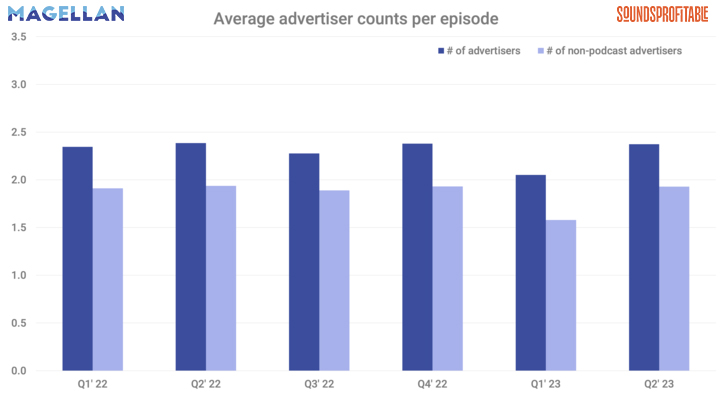This Week in the Business of Podcasting
Happy October to all who stretch the Halloween festive season out into a four-week affair. Fortunately for us there’s nothing frightening in the world of podcast news this week. Just reminders of podcasting’s power and what can be done when audiences are taken into consideration. Let’s get started.
Track behaviors, trends, and insights: Download Magellan AI’s podcast advertising benchmark report for Q2
Dentsu, GumGum, Iris.tv build video keyword targeting capability
From AdAge’s Jack Neff last Friday: Dentsu has announced a new partnership with GumGum and Iris.TV. Using GumGum’s Verity platform and Iris.tv, Dentsu’s Contextual Intelligence for CTV (connected television) service offers the ability to target keywords within video content. While this has been widely possible in text-based forms of advertising, the ability to transcribe and target keywords within video content opens up a variety of options both for brand safety control and serving relevant advertising.
Theoretically, Dentsu’s new tool will allow advertisers to specifically avoid individual topics, such as extreme violence, instead of outright blocking ads before every R-rated movie. While a welcome addition to the video side of advertising, it’s worth noting podcasting also has this tech and has been leveraging it for brand safety and suitability reasons. It’s worth noting keyword buying is already doable in podcasting, and both GumGum and Iris have been showing interest in the audio industry.
Advertising Campaigns for Hispanic Audiences Outside October
With Hispanic Heritage Month in full swing, we bring you two stories about marketing to Hispanic audiences outside of this month. First, from Acast and Henkel this Wednesday: a new brand lift study. According to Acast, a Q2 podcast advertising campaign for Schwarzkopf’s Keratin Color Haircare product had a purchase intent increase of 43%. The campaign targeted Hispanic podcast listeners through host-read spots on Spanish-language podcasts Yo Quiero Dinero and Se Regalan Dudas from April to July. Both host-read ad spots and integrated brand storytelling (either as four minute “sponsored stories,” or full branded episodes about the host’s experiences with changing hairstyles) were used to bring authenticity to the campaign.
The benefits of authentic advertising are clear outside of audio, as well. This week, AdWeek covered Danone North America’s always-on approach to Hispanic-targeting campaigns since 2021. After successful initial test campaigns in English, the campaigns were upgraded to Spanish-language creatives in national campaigns.
Unfortunately Danone’s story remains an outlier, not the norm. A performance agency rep told AdWeek some companies looking to reach Hispanic audiences set themselves up for failure by only running test campaigns with budgets too small to generate meaningful results. Or they fail to target publications specifically serving Hispanic audiences.
As much as it might seem self-explanatory, it’s worth noting the importance of building ad creative for the intended audience. As the recent Edison RADAR report we covered last week showed, podcasting’s Hispanic audience is a powerful one if the content is made accessible and relevant.
YouTube’s Current (and Potential Future) Place in Podcasting
Last Friday from Adam Bowie: a look into YouTube’s present place in podcasting, and where it can go. Bowie breaks down YouTube’s current place in the podcasting sphere, how it might have been accidentally overlooked, and unanswered questions that could evolve YouTube’s place in podcasting. A quote from Bowie:
“There is a massive opportunity here. YouTube and YouTube Music potentially can give a bit of kickstart to many of those who have yet to start listening to podcasts. Recall that even in the US, where podcasting is perhaps most established, only 42% of the population listen to a podcast each month. That means that 58% of the US population don’t regularly listen to podcasts. And that number is significantly higher in other parts of the world that have smaller podcasting ecosystems, and are likely to be more dominated by Android phone ownership.”
With YouTube’s RSS feed ingestion only just now entering into beta, we’ve yet to see the impact of audio podcasting fully integrated into YouTube music. Bowie argues that, despite the apparent lackluster support of audio-only podcast videos, there’s utility to YouTube. When revisiting research done by Ashley Carman several weeks ago, Bowie finds podcasts uploading their audio with a static image background, or simple audiogram animations, tend to perform poorly, even on channels with sizable subscriber bases.
The eternal question of “what is a podcast” complicates research into the top contenders, as studies like those from Podtrac don’t even mention YouTube due information being collected via RSS prefix. Meanwhile gray area productions, such as content exclusive to Spotify, Audible, and other platforms continue to be classified as ‘podcasts.’ As the medium and platforms evolve, it’s important to remember the malleable nature of the term ‘podcast’ when getting a big-picture perspective of the industry.
Industry Insights with Magellan AI
In Q2 2023 the average podcast episode had 2.4 advertisers, across 2.9 ads on average. By contrast in Q1 2023 episodes had on average 2 advertisers across 2.5 ads. In Q2 2023 the most common spots were 30s mid-rolls.
Looking to get a handle on podcast advertising metrics? Book a demo with the Magellan AI team.
Quick Hits
While they may not be top story material, the articles below from this week are definitely worth your time:
- Why Branded Content Could Be Bigger Than You Think by Tom Webster. In this week’s Sounds Profitable newsletter, Tom takes a look at the potential for brands and podcasts, and how data shows they have even more room to grow.
- The Power of Brands in Podcasts to debut October 18th. The free webinar debuting Sounds Profitable’s latest study, looking into the listeners of branded content and how to engage them, will be at 2:00 p.m. Eastern Standard Time on Wednesday, October 18th. Registration is available now.
- Why Now is a Great Time to Make Money With a Podcast by Robert Tuchman. Coverage of a panel with representatives from Hubspot, Quill, Amaze Media Labs, Conde Nast, and Adalyst Media.
- Amazon Music launches Podcast Previews in several global markets by Reem Makari. The Podcast Preview program, a podcast discoverability tool that displays hand-selected podcast clips to news listeners based on contextual data, is now available outside the US.
- Why Spotify is Growing its Connected TV Ad Business by Parker Herren. Spotify has partnered with Roku, the first step in establishing the Spotify CTV Partner Network to serve audio ads in the Spotify app available on smart TVs.
- Libsyn Unveils September 2023 Podcast Advertising Rates; Enhances Brand Safety Measures with ComScore Technology. The average cost per thousand impressions for a sixty second podcast ad increased in September to $22.91, a 3.8% month-over-month increase that breaks a three-month downward trend.









































































































































































































